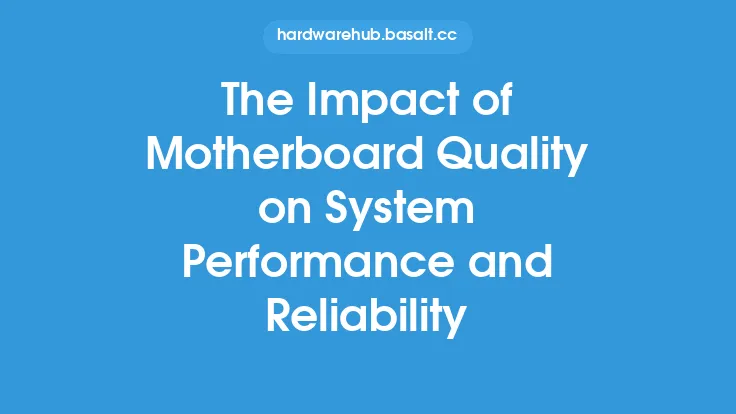When it comes to CPU overclocking, one of the primary concerns for enthusiasts and beginners alike is the potential impact on system stability and reliability. Overclocking, by its very nature, involves pushing the CPU beyond its factory-specified speeds, which can lead to increased heat generation, power consumption, and stress on the system's components. In this article, we will delve into the intricacies of how CPU overclocking affects system stability and reliability, exploring the technical aspects and providing insights into the potential risks and benefits.
Introduction to System Stability and Reliability
System stability and reliability are critical factors in determining the overall performance and lifespan of a computer system. Stability refers to the system's ability to operate without crashes, freezes, or errors, while reliability pertains to its capacity to function consistently over time without failing or experiencing downtime. When overclocking a CPU, it is essential to consider the potential effects on these two aspects, as excessive overclocking can lead to system instability, data corruption, and even hardware damage.
The Effects of Overclocking on CPU Temperature
One of the primary concerns when overclocking a CPU is the increase in temperature. As the CPU operates at higher speeds, it generates more heat, which can lead to thermal throttling, reduced performance, and even system crashes. Modern CPUs are designed to operate within a specific temperature range, typically between 60°C to 90°C. Exceeding this range can cause the CPU to throttle its performance, reducing its clock speed to prevent overheating. In extreme cases, prolonged exposure to high temperatures can lead to permanent damage to the CPU or other system components.
Power Consumption and Voltage Increases
Overclocking a CPU also results in increased power consumption, which can lead to higher electricity bills and increased heat generation. As the CPU operates at higher speeds, it requires more power to maintain stability, which can lead to increased voltage levels. Higher voltage levels can cause the CPU to generate more heat, creating a vicious cycle that can lead to system instability and reduced reliability. Furthermore, increased power consumption can also lead to reduced lifespan of the CPU and other system components, such as the motherboard and power supply.
System Component Stress and Wear
Overclocking a CPU can also lead to increased stress and wear on other system components, such as the motherboard, RAM, and storage devices. As the CPU operates at higher speeds, it can generate more electrical noise, which can interfere with the operation of other components. Additionally, the increased power consumption and heat generation can lead to reduced lifespan of these components, causing them to fail prematurely. It is essential to consider the potential effects of overclocking on these components and take necessary precautions to ensure their reliability and longevity.
The Role of Cooling Systems in Maintaining Stability
Adequate cooling is critical in maintaining system stability and reliability when overclocking a CPU. A good cooling system can help to dissipate heat generated by the CPU, reducing the risk of overheating and thermal throttling. There are various cooling solutions available, including air coolers, liquid coolers, and heat sinks. The choice of cooling system depends on the specific overclocking setup, the CPU's thermal design power (TDP), and the system's overall power consumption. It is essential to select a cooling system that can effectively dissipate heat and maintain a stable temperature, ensuring the system's reliability and performance.
Monitoring and Maintenance for Optimal Stability
To ensure optimal system stability and reliability when overclocking a CPU, it is crucial to monitor the system's performance and maintain it regularly. This includes monitoring CPU temperature, voltage levels, and power consumption, as well as performing regular system cleanups, updates, and backups. Additionally, it is essential to use high-quality components, such as a reliable power supply, a sturdy motherboard, and high-performance RAM, to ensure the system's stability and reliability. By taking these precautions, enthusiasts can enjoy the benefits of overclocking while minimizing the risks to their system's stability and reliability.
Conclusion and Best Practices
In conclusion, CPU overclocking can have a significant impact on system stability and reliability, and it is essential to consider these factors when pushing the CPU beyond its factory-specified speeds. By understanding the effects of overclocking on CPU temperature, power consumption, and system component stress, enthusiasts can take necessary precautions to ensure their system's stability and reliability. This includes selecting a suitable cooling system, monitoring system performance, and maintaining the system regularly. By following best practices and taking a cautious approach to overclocking, enthusiasts can enjoy improved system performance while minimizing the risks to their hardware.





